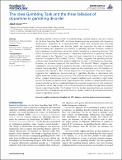| dc.contributor.author | Linnet, Jakob | en_US |
| dc.date.accessioned | 2014-03-10T20:33:44Z | |
| dc.date.issued | 2013 | en_US |
| dc.identifier.citation | Linnet, Jakob. 2013. “The Iowa Gambling Task and the three fallacies of dopamine in gambling disorder.” Frontiers in Psychology 4 (1): 709. doi:10.3389/fpsyg.2013.00709. http://dx.doi.org/10.3389/fpsyg.2013.00709. | en |
| dc.identifier.issn | 1664-1078 | en |
| dc.identifier.uri | http://nrs.harvard.edu/urn-3:HUL.InstRepos:11878872 | |
| dc.description.abstract | Gambling disorder sufferers prefer immediately larger rewards despite long term losses on the Iowa Gambling Task (IGT), and these impairments are associated with dopamine dysfunctions. Dopamine is a neurotransmitter linked with temporal and structural dysfunctions in substance use disorder, which has supported the idea of impaired decision-making and dopamine dysfunctions in gambling disorder. However, evidence from substance use disorders cannot be directly transferred to gambling disorder. This article focuses on three hypotheses of dopamine dysfunctions in gambling disorder, which appear to be “fallacies,” i.e., have not been supported in a series of positron emission tomography (PET) studies. The first “fallacy” suggests that gambling disorder sufferers have lower dopamine receptor availability, as seen in substance use disorders. However, no evidence supported this hypothesis. The second “fallacy” suggests that maladaptive decision-making in gambling disorder is associated with higher dopamine release during gambling. No evidence supported the hypothesis, and the literature on substance use disorders offers limited support for this hypothesis. The third “fallacy” suggests that maladaptive decision-making in gambling disorder is associated with higher dopamine release during winning. The evidence did not support this hypothesis either. Instead, dopaminergic coding of reward prediction and uncertainty might better account for dopamine dysfunctions in gambling disorder. Studies of reward prediction and reward uncertainty show a sustained dopamine response toward stimuli with maximum uncertainty, which may explain the continued dopamine release and gambling despite losses in gambling disorder. The findings from the studies presented here are consistent with the notion of dopaminergic dysfunctions of reward prediction and reward uncertainty signals in gambling disorder. | en |
| dc.language.iso | en_US | en |
| dc.publisher | Frontiers Media S.A. | en |
| dc.relation.isversionof | doi:10.3389/fpsyg.2013.00709 | en |
| dc.relation.hasversion | http://www.ncbi.nlm.nih.gov/pmc/articles/PMC3792697/pdf/ | en |
| dash.license | LAA | en_US |
| dc.subject | Review Article | en |
| dc.subject | gambling disorder | en |
| dc.subject | Iowa Gambling Task (IGT) | en |
| dc.subject | dopamine | en |
| dc.subject | addiction | en |
| dc.subject | positron-emission tomography | en |
| dc.title | The Iowa Gambling Task and the three fallacies of dopamine in gambling disorder | en |
| dc.type | Journal Article | en_US |
| dc.description.version | Version of Record | en |
| dc.relation.journal | Frontiers in Psychology | en |
| dash.depositing.author | Linnet, Jakob | en_US |
| dc.date.available | 2014-03-10T20:33:44Z | |
| dc.identifier.doi | 10.3389/fpsyg.2013.00709 | * |
| dash.contributor.affiliated | Linnet, Jakob | |


